Overview
The article "5 Steps to Build a Successful Marketplace Website" serves as a comprehensive guide to creating an effective online marketplace. It asserts that the key to success lies in:
- A well-defined marketplace concept
- Thorough market research
- The selection of an appropriate business model
- A strategic launch
- Robust marketing strategies
Each of these elements is crucial for establishing a competitive and sustainable platform, providing a solid foundation for any entrepreneur looking to thrive in the digital marketplace.
Introduction
Creating a successful marketplace website is a complex endeavor that demands meticulous planning and execution. Entrepreneurs face a competitive landscape, striving to satisfy the needs of both buyers and sellers. This article delineates five essential steps that will empower individuals to establish a thriving online marketplace, from defining a unique concept to implementing effective marketing strategies.
However, what challenges may arise during this journey, and how can they be surmounted to secure long-term success?
Define Your Marketplace Concept and Purpose
To effectively develop your platform, begin by articulating its fundamental idea. Consider these essential questions for your marketplace website:
- What products or services will you offer?
- Who are your target buyers and sellers?
- What does your marketplace website provide in comparison to existing options?
Documenting your responses is crucial, as it establishes a clear vision that serves as a guiding framework throughout the development process. This clarity is vital, ensuring that every decision aligns with your marketplace website's purpose, ultimately enhancing its value proposition.
Industry leaders emphasize that a well-defined vision for the market is indispensable for success. Rob Mihalko, a seasoned expert in digital platforms, asserts, "Understanding the fundamental purpose of your platform is essential for maintaining focus and alignment as you grow." Successful concepts in the equipment manufacturing sector, such as Showfields and Neighborhood Goods, exemplify how a strong market identity can attract both buyers and sellers, fostering a thriving ecosystem.
Statistics reveal that platforms with a clearly defined purpose are more likely to achieve sustainable growth. For instance, platforms that concentrate on their primary objective can generate significant economic value, as highlighted by industry insights. By dedicating time to this critical step, you prepare your platform for long-term success in a competitive environment.
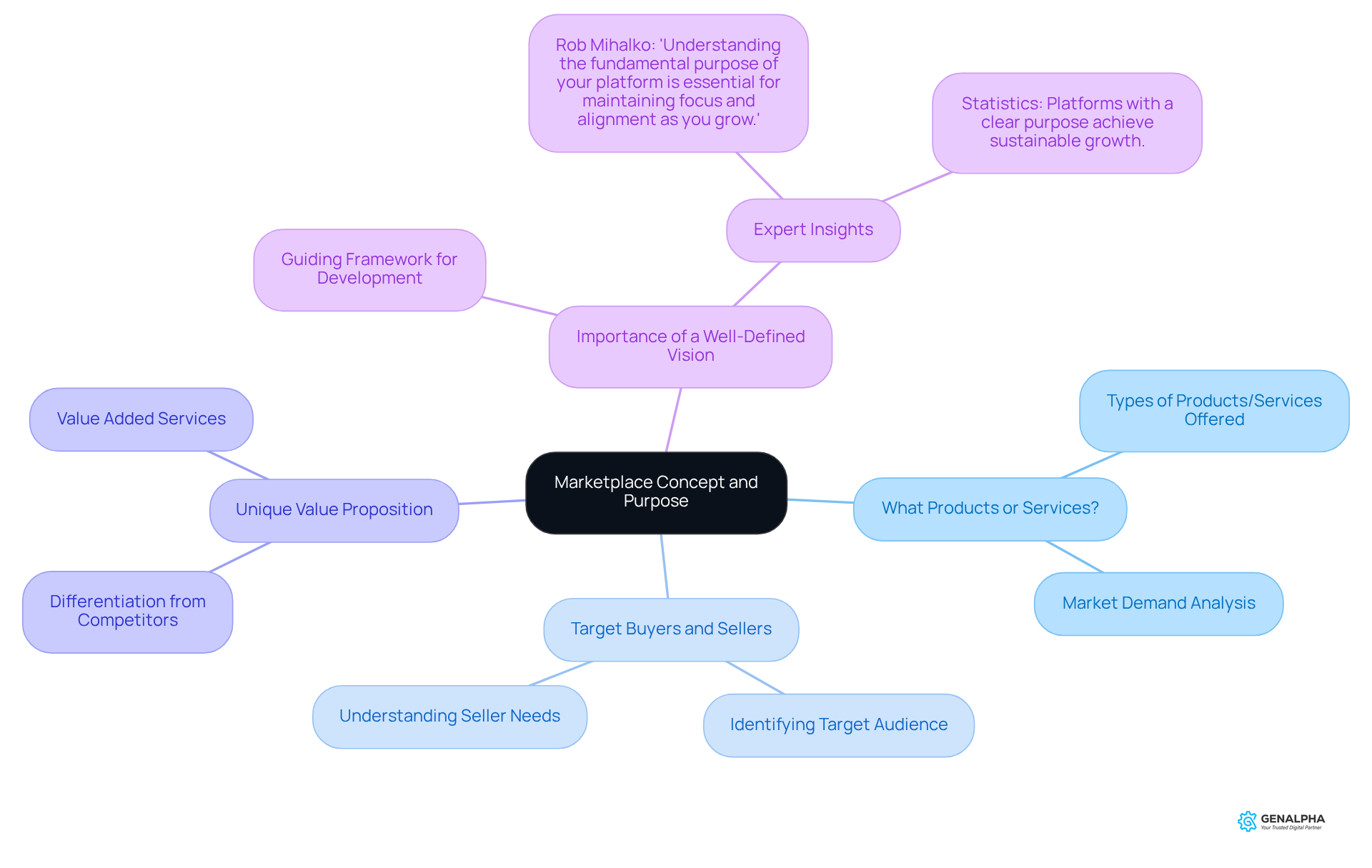
Conduct Market Research and Validate Your Idea
Conducting thorough market research is essential to validate your business concept in today's competitive landscape. Here’s how to effectively approach this critical task:
- Identify Competitors: Analyze current platforms offering similar products or services. What are their strengths and weaknesses? Understanding the is crucial for positioning your business effectively.
- Gather Customer Feedback: Utilize surveys, interviews, or focus groups to delve into potential customers' needs and preferences. This feedback is invaluable in shaping your offering to meet market demands.
- Analyze Trends: Investigate industry trends that indicate a growing demand for your business idea. Recognizing these patterns can provide a significant advantage in your market strategy.
- Test Your Idea: Develop a landing page or a prototype to gauge interest and collect feedback before fully committing to development. This step allows you to refine your concept based on real-world insights.
This comprehensive research will not only help you refine your concept but also ensure it aligns with market demands, setting the stage for successful implementation.
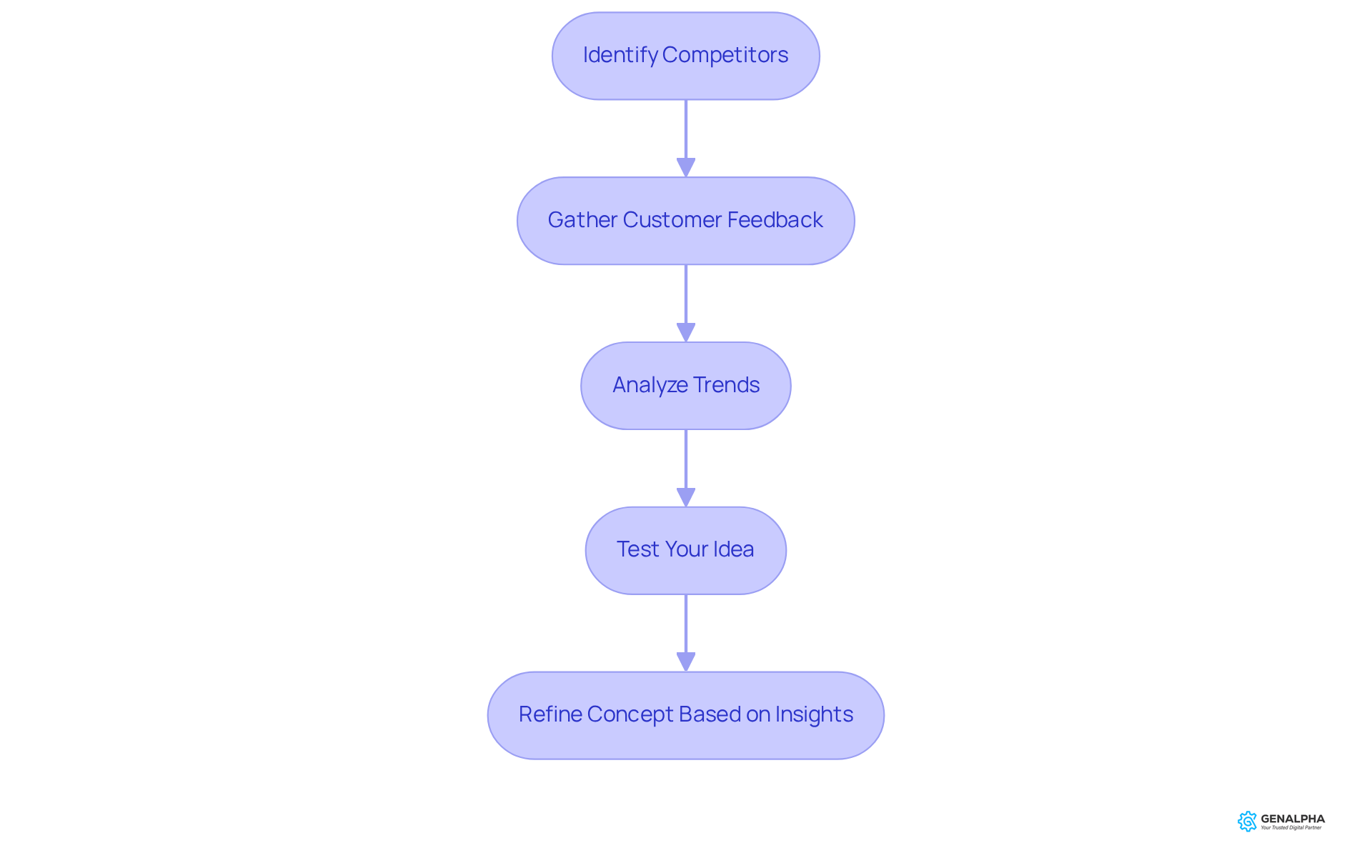
Choose a Business Model and Select the Right Platform
Selecting the right business model is paramount for your marketplace's success. Common models include:
- Commission-based: This model charges a fee for each transaction, aligning the platform's success with that of its vendors. Services such as Upwork and Etsy exemplify this method, taking a portion of each sale, which incentivizes them to promote seller success.
- Subscription-based: Vendors pay a monthly fee to list their products, providing a predictable revenue stream for the marketplace. The subscription economy market was valued at $650 billion in 2020 and is projected to reach $1.5 trillion by 2025, underscoring the growing significance of this model. However, businesses should remain vigilant, as the average monthly churn rate for subscriptions stands at 4.1%, presenting challenges for retention.
- Freemium: Basic services are offered at no cost, while premium features are available for a fee. This model initially attracts users, allowing them to before making a financial commitment.
Once you've selected a business model, it is essential to choose a system that aligns with your strategy. Consider the following factors:
- Ease of Use: The platform must be intuitive for both buyers and sellers, ensuring a smooth user experience that fosters engagement.
- Scalability: Opt for a system that can grow with your marketplace, accommodating increased traffic and transactions without compromising performance. Multi-vendor architecture is particularly advantageous in this regard, as it supports scalability while facilitating continuous enhancements.
- Integration: Ensure the system can seamlessly connect with existing frameworks, such as payment gateways and inventory management tools, to streamline operations and enhance efficiency.
Research various platforms, including Shopify and Sharetribe, or contemplate custom solutions tailored to your specific needs. By thoroughly assessing these factors, you can establish a robust foundation for your platform that meets both vendor and customer expectations. Additionally, be cognizant of potential revenue leakage due to billing issues, which affects 42% of companies. By addressing these considerations, you can cultivate a successful platform that thrives within the competitive landscape.
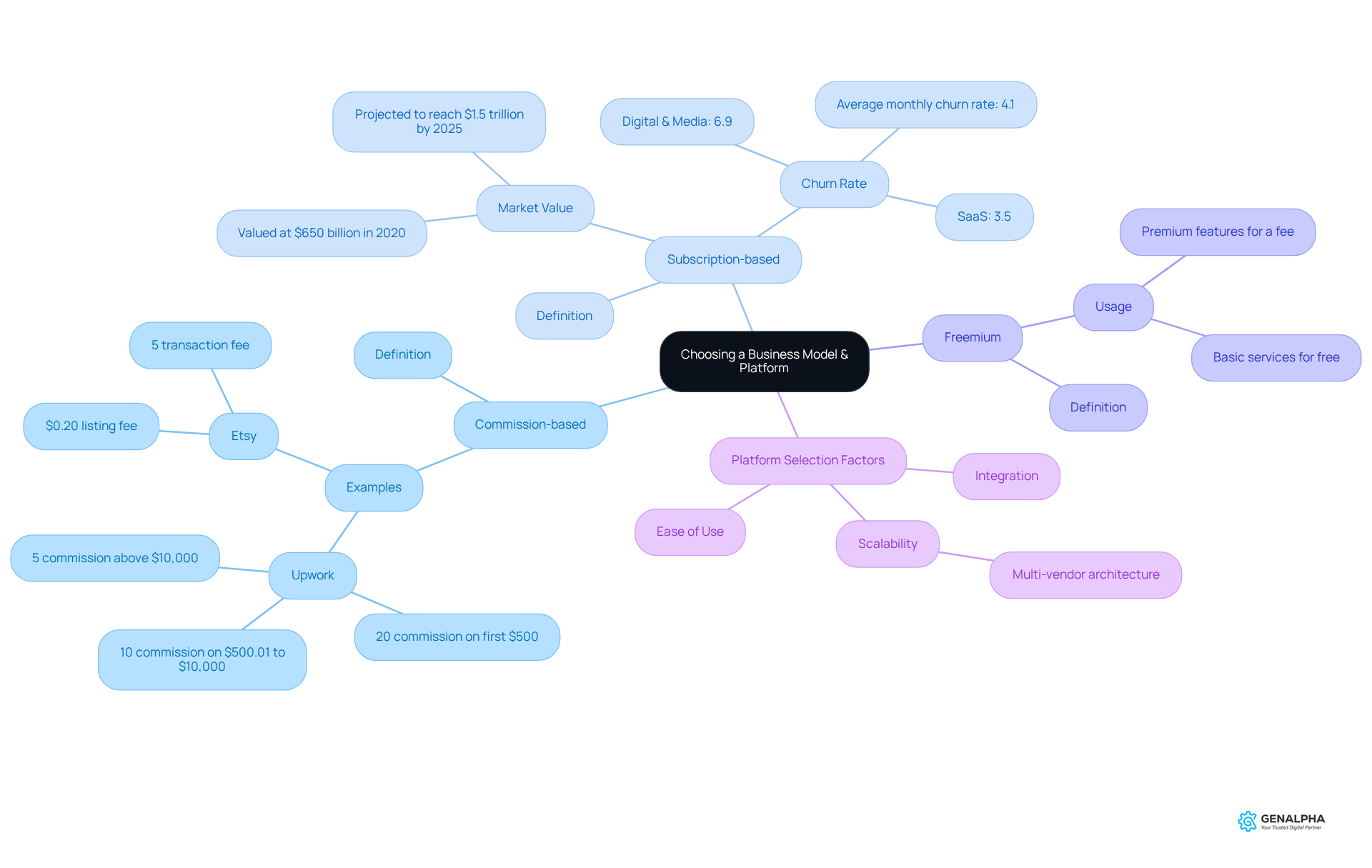
Launch Your Marketplace and Attract Users
Launching your platform necessitates a meticulously crafted strategy to guarantee success. A well-structured launch plan is essential. Develop a comprehensive strategy that outlines your launch timeline and key milestones; this plan will serve as a roadmap for the introduction of your marketplace website to the market.
Building anticipation is crucial. Leverage social media, email marketing, and content marketing to generate excitement leading up to the launch. Engaging potential customers through these channels can significantly enhance visibility and interest. Notably, nearly 30% of B2B marketers assert that Facebook delivers the best value for their organizations, making it an optimal platform for fostering anticipation.
Engaging early users is vital. Incentivize early adopters with exclusive offers, such as discounts or early access to features. This approach not only promotes initial registrations but also cultivates a sense of community among your early participants. Statistics reveal that 73% of American consumers prefer to purchase a product after watching a product video, underscoring the importance of engaging content.
Gathering feedback post-launch is imperative. Actively solicit opinions from individuals to identify strengths and areas for enhancement. This engagement is essential for refining your platform and boosting customer satisfaction. Utilizing can streamline this feedback process.
Monitoring performance is key. Employ analytics tools to track audience engagement and sales metrics. This information will aid in comprehending consumer behavior and enhancing your market strategy for sustained growth. Be cautious of potential pitfalls, such as neglecting user feedback or failing to adapt to market changes.
A successful launch of your marketplace website not only establishes the tone for the growth of your platform but also lays the groundwork for ongoing user engagement and satisfaction.
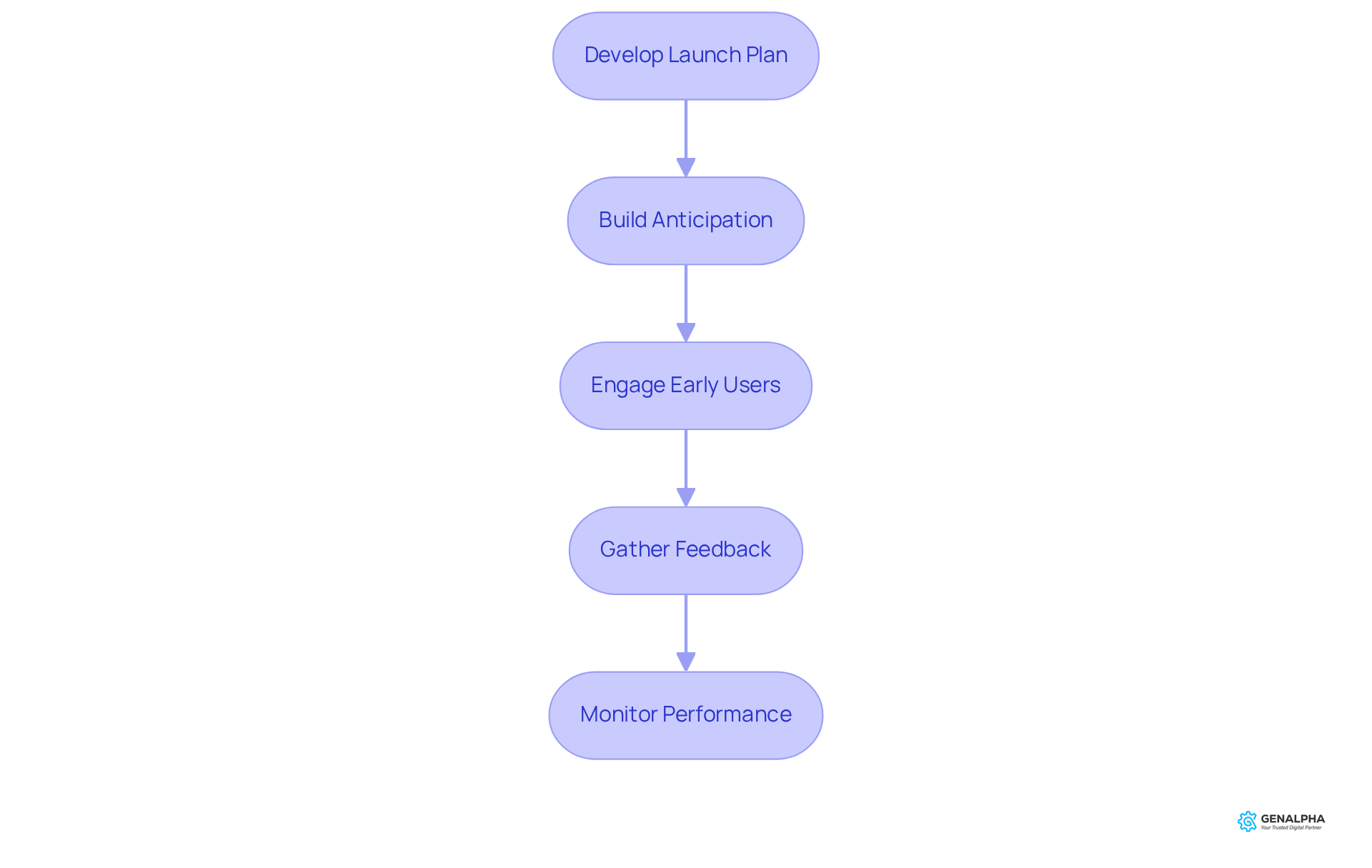
Implement Marketing Strategies and Ensure Competitiveness
To maintain a competitive edge in the marketplace, it is essential to implement effective marketing strategies. Consider the following approaches:
- Search Engine Optimization (SEO): Optimizing your website for search engines is paramount to enhance visibility and drive organic traffic. With organic search accounting for approximately 94% of all clicks, are crucial for attracting potential customers. Focus on integrating relevant keywords, optimizing listings, and ensuring mobile-friendliness, as mobile traffic now constitutes 60% of all web traffic. Notably, the #1 organic result garners 39.8% of all clicks, underscoring the importance of ranking high in search results.
- Content Marketing: Developing high-quality content that addresses your audience's pain points and interests is vital. Engaging content not only establishes authority but also drives traffic; content exceeding 3,000 words can generate four times more shares and 3.5 times more backlinks than shorter articles. Successful examples include educational blog posts and user-generated content that resonate with your target market.
- Social Media Marketing: Utilizing social media platforms to interact with individuals and promote your market can be transformative. Regular interaction fosters community building and can turn community members into brand ambassadors, enhancing word-of-mouth marketing. Video content, which boasts a 41% higher click-through rate than text-only pages, is particularly effective in capturing attention and is also 50 times more likely to rank among the top results on Google's first page.
- Email Campaigns: Implementing targeted email campaigns keeps users informed about new products, features, and promotions. Personalized emails can significantly increase engagement and conversion rates, making them a vital tool for nurturing customer relationships.
- Partnerships and Collaborations: Collaborating with influencers or other businesses can expand your reach. Strategic partnerships enhance credibility and introduce your marketplace to new audiences, driving traffic and potential sales.
Regularly assess your marketing efforts by tracking key performance indicators (KPIs) such as conversion rates and customer acquisition costs. Adjust your strategies based on these insights to ensure you remain ahead of competitors in the evolving digital landscape.
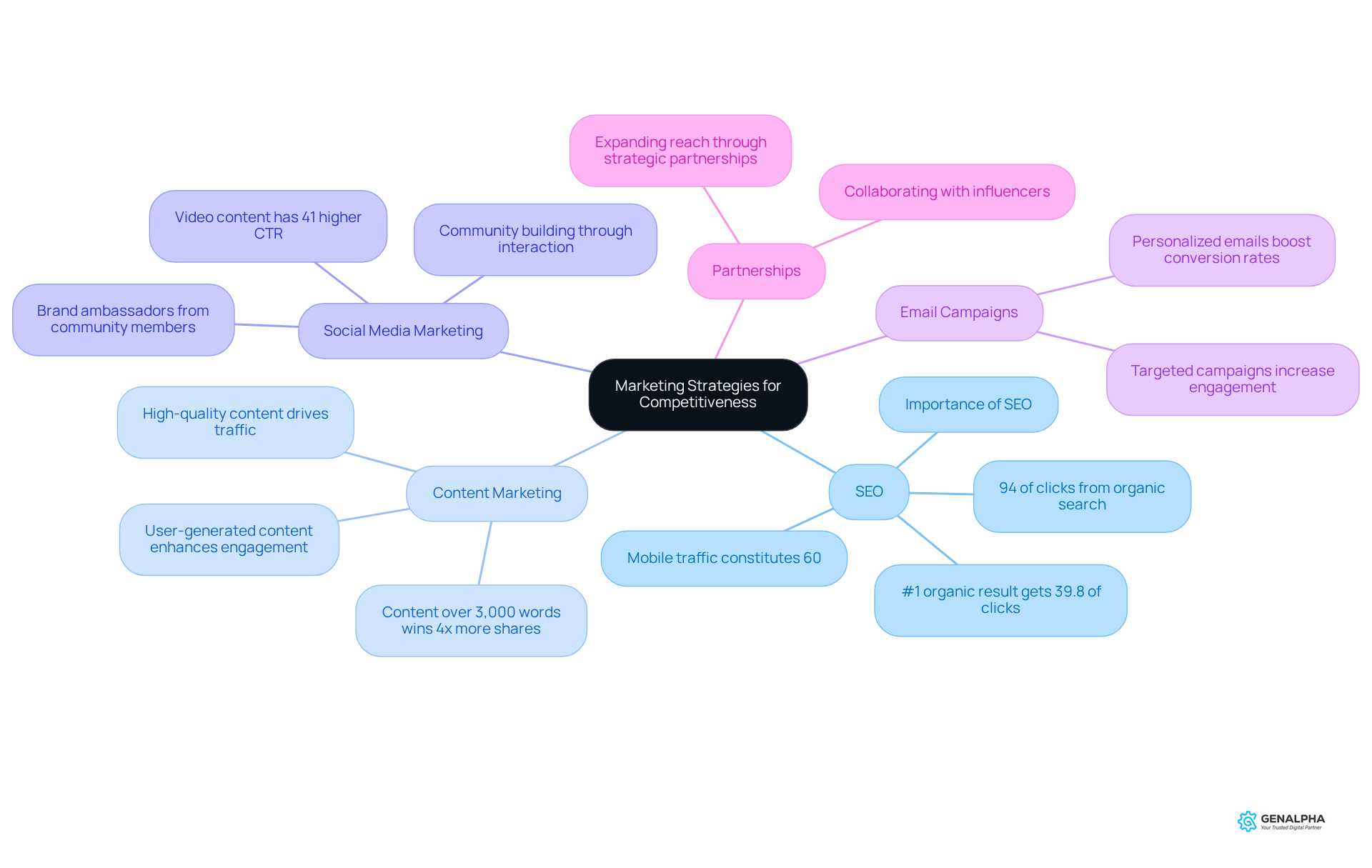
Conclusion
Building a successful marketplace website necessitates a strategic approach that encompasses:
- Defining a clear concept
- Conducting thorough market research
- Selecting an appropriate business model
- Launching effectively
- Implementing robust marketing strategies
Each of these steps is interlinked and essential for establishing a platform that not only attracts users but also sustains long-term growth and competitiveness.
The importance of a well-defined marketplace purpose cannot be overstated; clarity in vision serves as a guiding force for development and enhances the platform's value proposition. Key insights such as:
- Understanding the competitive landscape
- Validating ideas through customer feedback
- Choosing the right business model
are crucial for positioning the marketplace effectively. Furthermore, launching with a solid strategy and engaging users through targeted marketing efforts establishes a strong foundation for ongoing success.
Ultimately, the journey to creating a thriving marketplace is an ongoing process that demands adaptability and responsiveness to market changes. By following these outlined steps and prioritizing user engagement and satisfaction, entrepreneurs can cultivate a dynamic platform that stands out in the digital marketplace landscape. Taking decisive action and implementing these strategies will lead to the realization of a successful marketplace that meets the needs of both buyers and sellers in an ever-evolving environment.
Frequently Asked Questions
What is the first step in developing a marketplace website?
The first step is to define your marketplace concept and purpose by articulating its fundamental idea, including what products or services will be offered, identifying target buyers and sellers, and determining the unique value of your marketplace compared to existing options.
Why is documenting the marketplace concept important?
Documenting the responses to key questions establishes a clear vision that serves as a guiding framework throughout the development process, ensuring that every decision aligns with the marketplace's purpose and enhances its value proposition.
What do industry leaders say about having a well-defined vision for a marketplace?
Industry leaders emphasize that a well-defined vision is essential for success. Rob Mihalko states that understanding the fundamental purpose of your platform is crucial for maintaining focus and alignment as the business grows.
How can platforms achieve sustainable growth?
Platforms with a clearly defined purpose are more likely to achieve sustainable growth, as they can generate significant economic value by concentrating on their primary objectives.
What is the importance of conducting market research for a marketplace?
Conducting thorough market research is essential to validate your business concept, understand the competitive landscape, gather customer feedback, analyze industry trends, and test your idea before fully committing to development.
What methods can be used to gather customer feedback?
Customer feedback can be gathered through surveys, interviews, or focus groups to understand potential customers' needs and preferences.
How can analyzing trends benefit a marketplace?
Investigating industry trends can indicate a growing demand for your business idea, providing a significant advantage in your market strategy.
What is a practical step to test a marketplace idea?
Developing a landing page or a prototype can help gauge interest and collect feedback, allowing you to refine your concept based on real-world insights before fully committing to development.




